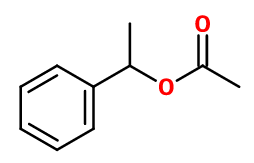
Photo credits: ScenTree SAS
| Company | Ingredient Name | ID | Comments | Naturality | Certifications | Purity | Latin name | Treated part | Geographical origin | MOQ |
|---|---|---|---|---|---|---|---|---|---|---|
|
|
Acetate de Styrallyle - 30 Gr | - |
Visit website
|
- | - | - | - | - | - |
General Presentation
-
CAS N° : 93-92-5
-
EINECS number : 202-288-5
-
FEMA number : 2684
-
FLAVIS number : 09.178
-
JECFA number : 801
-
Appearance : Colorless liquid
-
Density : 1,025
-
Volatility : Head
-
Price Range : €
Physico-chemical properties
-
Molecular formula : C10H12O2
-
Molecular Weight : 164,2 g/mol
-
Log P : 2,5
-
Fusion Point : -60°C
-
Boiling Point : 212°C
-
Detection Threshold : Donnée indisponible.
-
Optical rotation : Donnée indisponible
-
Vapor pressure : Donnée indisponible
-
Refractive Index @20°C : Donnée indisponible
-
Acid Value : Donnée indisponible.
-
Flash Point : 95°C
Uses
Uses in perfumery :
Styrallyl acetate is used in rhubarb, gardenia and tuberose notes. Gives an attack to rosy notes. Widely used in both men and women perfumery for a modern look and to dry out top notes.
Year of discovery :
1911
Natural availability :
Styrallyl acetate is available as nature identical
Isomerism :
Styrallyl acetate has an asymmetric carbon. Its (R) enantiomer has a very floral-jasmine smell, close to gardenia and fruity. The (S) enantiomer is closer to strawberry and has a green and fresh note. In perfumery, the racemic mixture of these two enantiomers is the only one that is used. Phenyl Ethyl acetate and Benzyl Propionate are constitution isomers of Styrallyl acetate. Nevertheless, Phenyl Ethyl acetate is more rosy and honeyed, and Benzyl Propionate is more floral, reminiscent of jasmine and pear.
Synthesis precursor :
Styrallyl acetate is not a precursor to the synthesis of another compound of olfactory interest.
Synthesis route :
Styrallyl acetate results from an esterification reaction between 1-phenylethanol and acetic acid or acetic anhydride in the presence of an acid catalyst.
Regulations & IFRA
Allergens :
This ingredient does not contain any allergen.
IFRA 51th :
This ingredient is not restricted for the 51th amendment

